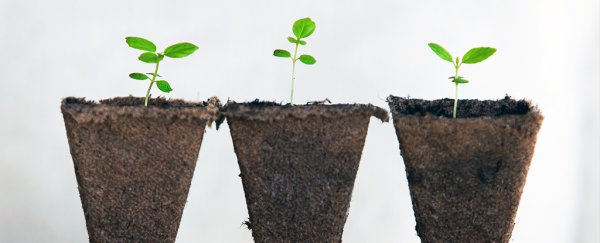We know that plants can learn, and make decisions, and we now have a new level of insight into the decision-making process plants go through when put under pressure, vying with competitors for limited access to sunlight.
It turns out our flora friends can react to the size and strength of their nearby neighbours, deciding how best to survive considering what's happening around them, according to a new study.
Based on what they have to deal with, plants can either try to outgrow their competitors (confrontational vertical elongation) or go into a low-light survival mode (shade tolerance).
Some plants can even grow away from their close companions (avoidance behaviour), according to researchers from the University of Tübingen in Germany.
 Different plant scenarios (University of Tübingen)
Different plant scenarios (University of Tübingen)
"These three alternative responses of plants to light competition have been well-documented in the literature," says one of the team, Michal Gruntman.
"In our study we wanted to learn if plants can choose between these responses and match them to the relative size and density of their opponents."
In short: yes they can.
The searchers set up the plant Potentilla reptans in a variety of experimental settings, designed to mimic different scenarios in nature.
Vertical stripes of transparent green filters were used to control the amount of light available, as well as regulate the red to far-red wavelengths of the light – that's what plants use to sense when the light they're getting has been filtered through the leaves of neighbouring plant life.
When Potentilla reptans was tricked into thinking it was surrounded by small, dense vegetation, it tried to outgrow it vertically; when the environment mimicked tall competitors, the plant went into shade tolerance mode.
In that particular mode, plants will decrease their photosynthesis rates and make their leaves thinner and wider, in order to capture as much light as possible.
Finally, when the plant detected that it was surrounded by tall but sparsely planted rivals, which could only be outgrown by moving away, that's when the highest level of lateral-avoidance behaviours were noted.
All of which means we now know more about how plants work through their decisions and try and maximise the chances of life, even though they don't have working brains and nervous systems like we animals do.
Anyone who's watched a plant grow knows it will move towards the light – but it seems they're also adapting to what all the other plants are doing as well, and can do it relatively rapidly too, once the situation shifts.
Could this also apply to competition for other resources, and affect factors like root growth? That's the next stage of the research.
"Such an ability to choose between different responses according to their outcome could be particularly important in heterogeneous environments, where plants can grow by chance under neighbours with different size, age or density, and should therefore be able to choose their appropriate strategy," says Gruntman.
The findings have been published in Nature Communications.
